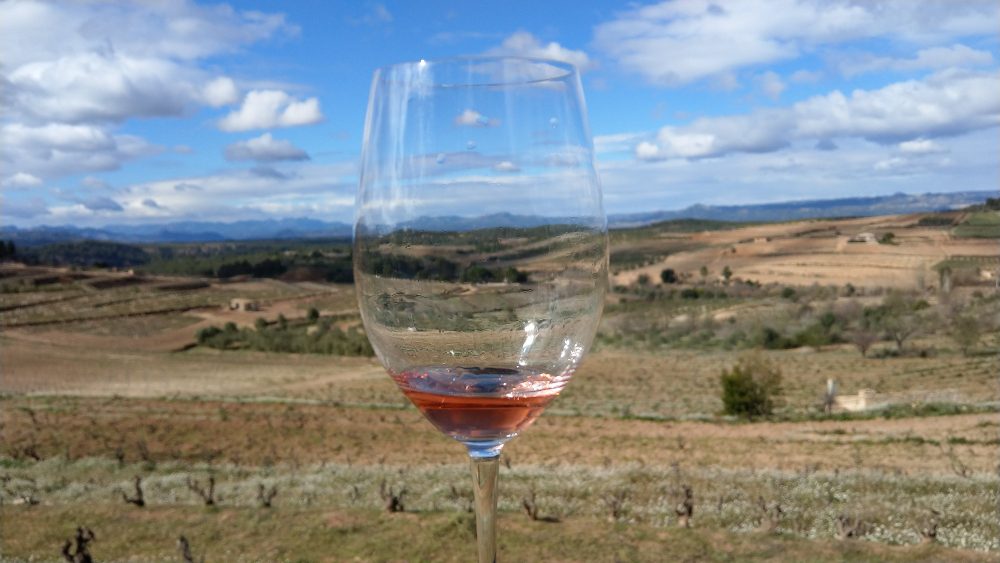Why do we need to know about the soil? I asked, when I was first learning about wine. Because the composition of the soil can determine which grape grows best in the vineyard.
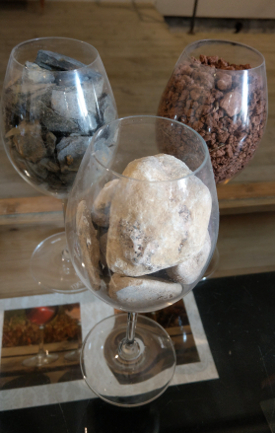 The type of soil also helps decide the irrigation method needed in the vineyard. For example limestone, or calcareous soils are somewhat compact. Their origin from the erosion and sedimentation of rivers, these soils are rich in calcium carbonate, and provide excellent water retention. In the winter time, they retain water, which is important to help the grapevines take in nutrients via their roots. Too much water is a bad thing, because waterlogged soils can increase the chance for root disease. Limestone's layers of thin sheets allow the soil the retain water during dry period, and drain properly during heavy rains. Granite soils, those made up of decomposed or eroded rock masses, and slate-based soils do not retain water very well, and are low in organic matter.
The type of soil also helps decide the irrigation method needed in the vineyard. For example limestone, or calcareous soils are somewhat compact. Their origin from the erosion and sedimentation of rivers, these soils are rich in calcium carbonate, and provide excellent water retention. In the winter time, they retain water, which is important to help the grapevines take in nutrients via their roots. Too much water is a bad thing, because waterlogged soils can increase the chance for root disease. Limestone's layers of thin sheets allow the soil the retain water during dry period, and drain properly during heavy rains. Granite soils, those made up of decomposed or eroded rock masses, and slate-based soils do not retain water very well, and are low in organic matter.
Last month, when we visited DO (Designation of Origin) Montsant, we encountered soil samples in nearly every winery. We tasted wines made exactly the same way, but with grapes than came from different soils types with noticeable differences. It's kind of a geeky science thing to study, but interesting to note how the wines differ in taste.
Red grapes comprise 94% of those planted and/or produced in DO Montsant's 61 wineries in 16 towns. Of the 10 red varieties grown, two make up a significant portion of the vineyards: Garnatxa Negra (or Red Grenache) and Carinyena (Carignan or Samso in Catalan) which account for 35.79% and 30.06% respectively. Both of these grow well in hot dry climates. Other minor grapes grown in DO Montsant include Ull de llebre, Syrah, Merlot, Cabernet Sauvignon, Garnatxa Peluda, Garnatxa Roja, Monastrell and Picapoll Negre. White grapes make up only 6% of those planted within DO Montsant. Two primary varieties make up nearly all the white grapes planted (94.06%); Garnatxa Blanca (White Grenache) and Macabeu (Viura) which is one of the main grapes in Prosecco. Very small percentages of other white grapes in DO Montsant include Chardonnay, Moscatell de Gra Petit, and the other two grapes in Prosecco: Xarel·lo and Parellada.
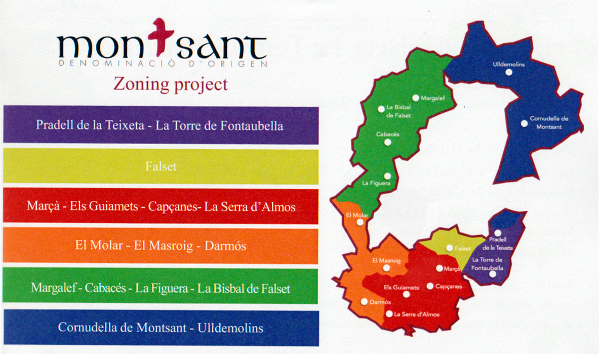 Ten years ago, in 2008, DO Montsant began an endeavor called The DO Montsant Zoning Project, based on elevation, average temperature and rainfall as well as slope and primary soils. This divided the Comarca del Priorat (or Priorat county) into six different zones.
Ten years ago, in 2008, DO Montsant began an endeavor called The DO Montsant Zoning Project, based on elevation, average temperature and rainfall as well as slope and primary soils. This divided the Comarca del Priorat (or Priorat county) into six different zones.
Pradell de la Teixeta, La Torre de Fontaubella
The Pradell de la Texieta, La Torre de Fontaubella is near the sea on the steep slopes behind the Pradell Mountain. It is the smallest zone with just 21.9 ha. It is occupied by just one winery, that owns most of the vineyards. It's the small purple section on the map in the lower right hand corner. With elevations from 330 - 420 meters above sea level at a 30% grade. Average temperature here is 14.02 C (or just over 57 degrees Fahrenheit) with average rainfall at 667.2 mm precipitation. Due to its higher altitude and cooler temperatures its vines are late to flower, late to ripen and therefore late to harvest. The area is primarily planted to Garnatxa Noir ( with Carignan (16.28%) and White Grenache and under 1% of Macabeu. Soils here are characterized as gravelly, sandy and limestone-based, loamy soils called "panal." Winery: Celler Sant Rafel
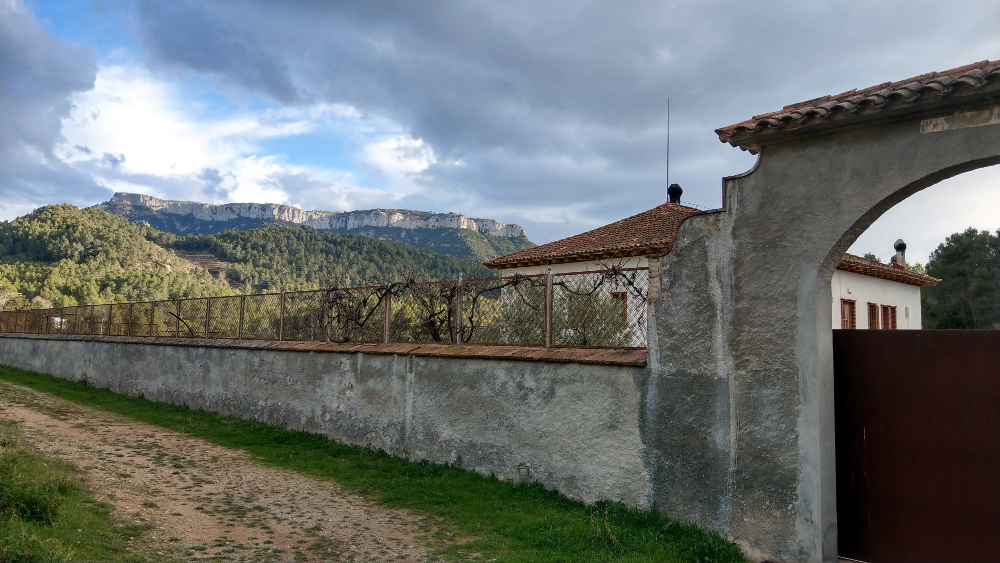
Falset
The main village and economic center of DO Montsant, the Falset zone is a southern area with lower slopes of 15% grade. Represented by the lime colored section on our map, Falset is relatively rainy due (649.9 mm annually) due to its proximity to the sea. With an elevation of 300 - 400 meters and average temperature of 14.97 C (58.95 F) vines of primarily Red Grenache (30.26%) flower, ripen and are harvested a bit earlier than those in The Pradell de la Texieta, La Torre de Fontaubella zone. Soils here and more sandy of decomposed granite (called "saulo"), with stony soil mix of Llicorella (slate) and granite. This area produces traditional Garnatxa-based wines.
Wineries: Portal de Priorat, Celler Clos Pissarra, Celler Comunica, Celler Laurona, Celler Pascona, Cellers Carafons-Osso, Cooperativa Falset Marca, Deva Montsant, El Vi dels 20, Finca Fontanals, Venue La Universal, Vins de Mas Sersal
Marçà, Capçanes, Els Guiamets, La Serra d'Almos
The most productive zone of the six, the zone of Marçà, Capçanes, Els Guiamets, and La Serra d'Almos sit on the flatter banks of the Ebro River in the southern part of the DO with some villages along the foothills of the Llaberia Mountain range. Represented above in the Red section, elevations here are 100 -500m high with a 14% grade. Average rainfall is 525 mm and temperatures average 16.05 C (60.89 F) The vineyards are planted primarily to Red Grenache (35.77%) and Carignan (23.81% ) with a small amount of White Grenache (2.35%) and Macabeu (1.65%) in Clay-based soils that offer good water retention. There are also Llicorella soils and soils which are a mix between sandy soils and loam.
Wineries: Acustic Celler, Agricola La Serra d'Almos, Amics del Gobe, Cal Besso, Celler Cedo Anguera, CellerClos Mersorah, Celler de Capcanes, Celler Els Guiamets, Celler La Placeta, Celler Unio, Celler Vermunver Josep Grau Viticultor, Portal del Montsant, Serra i Barcelo, Sui Genesis, Vendrell Rived, Vinas del Montant and Vinyes Domenech
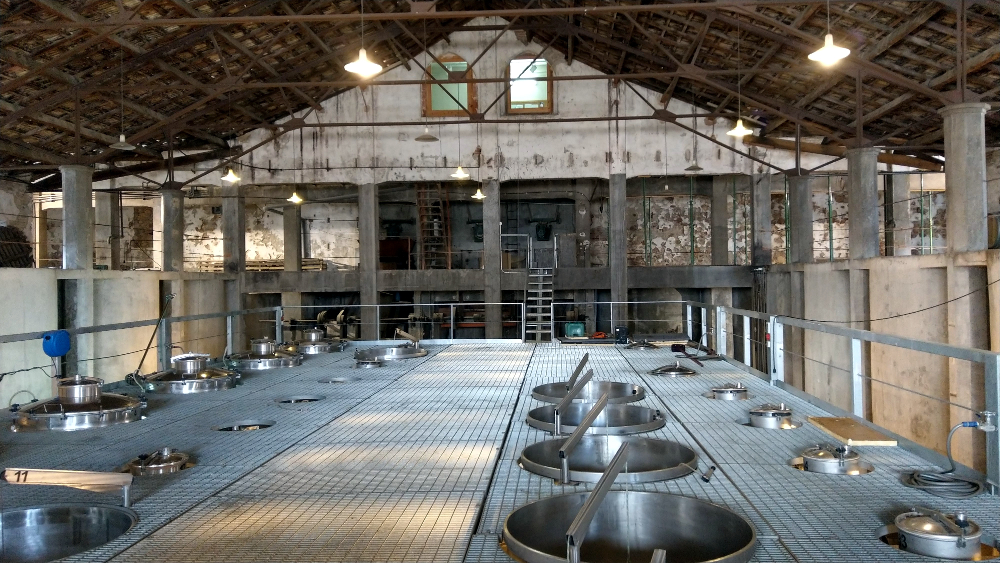
El Masroig, Darmos, El Molar
The El Masroig, Darmos, El Molar has many soil types including clays, loam and sandy as well as stonier soils of Llicorella. El Molar is a continuation of Priorat separated by the Siurana River from Masroig and Darmos, along the flatter banks of the Ebro River. This area includes 623.88 hectares of vineyards with the bulk devoted to Carignan, followed by Red Grenache, with small amounts of White Grenache and Macabeu. Represented by the orange shape, this zone's elevation is lower, 50 - 300 meters with a 17% grade. Average temperature is 15.55 C (60 F) and 440.7 mm rainfall. Vines bud and flower early, ripen early and are harvested earlier. The wines tend to be typically dark and big in style
Wineries: Celler AiBar, Celler Angeura Domenech, Celler Cairats, Celler el Masroig, Celler Russell Smith, Cellers Can Blau, Cellers Joan d'Anguera, Coca i Fito, Grifoil Declara Grup, Mas de l'Abundancia, Orto Vins and Vinyes d'en Gabriel
La Figuera, Cabaces, La Bisbal, Margalef
On the back slopes of the Montsant mountain range of calcareous or limestone based substrate covered with clay-based soils, we find the zone La Figuera, Cabaces, La Bisbal, Margalef. A region devoted to the Garnatxa grape, red Grenache makes up nearly 70% of the vines planted, with a small percentage of Carignan (4.81%) and Macabeu (3.82%) and a smattering of White Grenache (1.99%). Elevation is from 300 to 500 meters, with slope of 32%. La Figuera the highest area. Average temperature is 13.37 C (56 F) Temperatures are lower, but low rainfall (average is 395.23 mm) can create stress in hotter vintages.
Wineries: Agricola Aubacs i Solans, Celler Mas de les Vinyes, Ficaria Vins, Spectacle Vins
Cornudella de Montsant, Ulldemolins
On the steep slopes of the Montsant range we find Cornudella de Montsant, Ulldemolins with elevations of 400 to 700 meters and a 27% grade. Temperatures average 14.33 C (57.79 F) with rainfall averaging 484.74 mm. Vineyards are primarily planted to Red Grenache (44.68%) followed by Carignan (21.68%) Macabeu (5.57%) and White Grenache (5.52%) The Ulldemolins zones are characterized by loamy soils. Limestone-based soils, slate and round pebbles characterize the soils in Cornudella. A wide variety of wine styles come from these areas, many high in acid, slightly tight when young. The wines have a long ripening cycle after late budding and flowering, and are harvested late. According to the DO wines from this area are attracting attention from the top producers.
Wineries: Agricola d'Ulldemolins, Baronia del Montsant, Celler Cooperatiu de Cornudella, Celler Serra Major, Cingles Blaus, Mas Perinet, Noguerals, Ronadelles
For more information on the DO Montsant Zoning Project please visit www.domontsant.com


